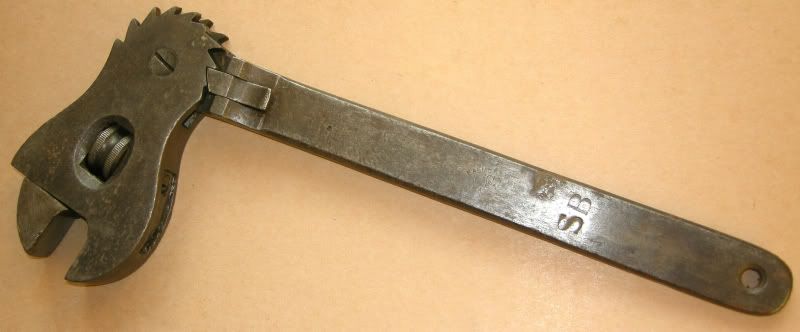magneticanomaly
Titanium
- Joined
- Mar 22, 2007
- Location
- On Elk Mountain, West Virginia, USA
Reading Joe Michaels' post about spud wrenches etc., spurs me to share and solicit thoughts about two adjustable wrench issues.
I was taught by my father to use an adjustable wrench (Crescent-style were what he had) so that, if you were pulling the wrench handle toward yourself, the adjustable jaw would also be on your side of a line through handle and bolt axis. This was supposed to take best advantage of the strength of the tool.
In later years, I came to disagree with this advice, although I think it is standard.
If you visualize how the jaws of the wrench bear on the nut or bolt-head corners, it will be seen that if you use the wrench as my father advised, the load is imposed near the tip of the movable jaw, and near the root of the fixed jaw. It seems obvious that the fixed jaw on a crescent style adj wrench is stronger than the movable one, so I now, whenever it is not hopelessly inconvenient, pull on an adjustable wrench from the side OPPOSITE the adjustable jaw.
I will offer my speculation as to why a technique IMHO incorrect is taught as standard. If I examine the construction of the old monkey-wrench on which the movable jaw is a sleeve around the shank at whose end the fixed jaw is formed, it appears to me that the movable jaw is the stronger, and this supposition is borne out by the large number of monkey wrenches I have seen (most of them!), whose jaws are no longer parallel because the shank has bent.
So, I believe the "standard advice" about how to use an adjustable wrench, was formulated and is correct for a monkey wrench, and has merely been transferred to the newer style wrench without being reevaluated and corrected.
Another tid-bit. My favorite Crescent-style adjustable wrenches are those made by JH Williams, Blackhawk...and I think one more mfr whose name escapes me at the moment. This is because the track for the rack on the movable jaw, and the rack itself, are D-shaped rather than cylindrical. This would seem a more expensive way to make them, because the track would have to be broached rather than only drilled. (I don't know, perhaps they are all broached to enlarge a milled slot) But the flat tracks normal to the stress tending to peel the movable jaw out of the handle, would not exert any force tending to wedge the cheeks of the handle apart, as the same pull on a cylindrical rack would. I think I have seen adjustable wrenches loose due to such wedging, 'though not near as many as sprung monkey wrenches.
I was taught by my father to use an adjustable wrench (Crescent-style were what he had) so that, if you were pulling the wrench handle toward yourself, the adjustable jaw would also be on your side of a line through handle and bolt axis. This was supposed to take best advantage of the strength of the tool.
In later years, I came to disagree with this advice, although I think it is standard.
If you visualize how the jaws of the wrench bear on the nut or bolt-head corners, it will be seen that if you use the wrench as my father advised, the load is imposed near the tip of the movable jaw, and near the root of the fixed jaw. It seems obvious that the fixed jaw on a crescent style adj wrench is stronger than the movable one, so I now, whenever it is not hopelessly inconvenient, pull on an adjustable wrench from the side OPPOSITE the adjustable jaw.
I will offer my speculation as to why a technique IMHO incorrect is taught as standard. If I examine the construction of the old monkey-wrench on which the movable jaw is a sleeve around the shank at whose end the fixed jaw is formed, it appears to me that the movable jaw is the stronger, and this supposition is borne out by the large number of monkey wrenches I have seen (most of them!), whose jaws are no longer parallel because the shank has bent.
So, I believe the "standard advice" about how to use an adjustable wrench, was formulated and is correct for a monkey wrench, and has merely been transferred to the newer style wrench without being reevaluated and corrected.
Another tid-bit. My favorite Crescent-style adjustable wrenches are those made by JH Williams, Blackhawk...and I think one more mfr whose name escapes me at the moment. This is because the track for the rack on the movable jaw, and the rack itself, are D-shaped rather than cylindrical. This would seem a more expensive way to make them, because the track would have to be broached rather than only drilled. (I don't know, perhaps they are all broached to enlarge a milled slot) But the flat tracks normal to the stress tending to peel the movable jaw out of the handle, would not exert any force tending to wedge the cheeks of the handle apart, as the same pull on a cylindrical rack would. I think I have seen adjustable wrenches loose due to such wedging, 'though not near as many as sprung monkey wrenches.




